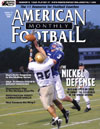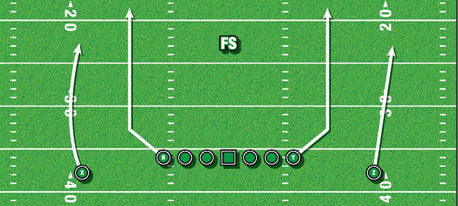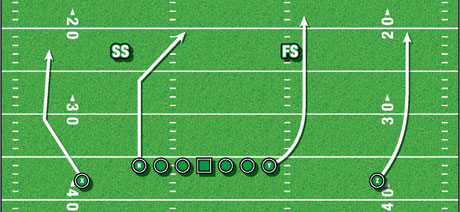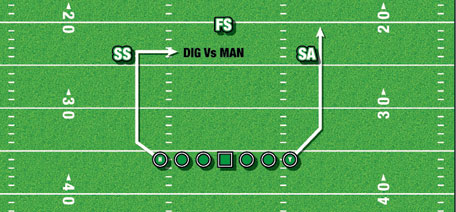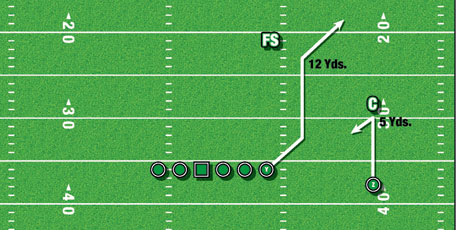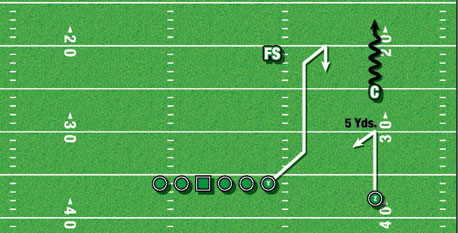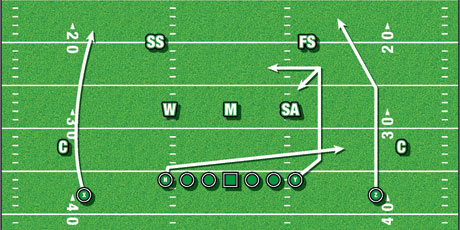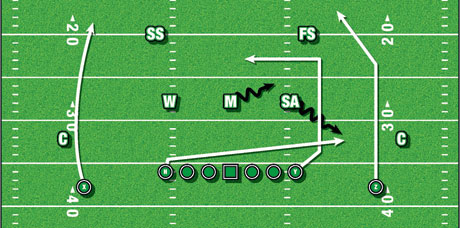Stretching the Field With Your Tight End
by: Phil RatliffTight Ends Coach, Marshall University©
More from this issue
Coaching tight ends at Marshall University has the best of both worlds. Our head coach Mark Snyder believes strongly in the use of the TE, while our offensive staff uses various schemes to implement them into the offense. Like most teams, we use a traditional TE with size to block defensive ends and also use their ability to be a part of the short passing game. In 2006, we found a hybrid TE to stretch the field and attack the defense with our vertical passing game. That year our TE’s combined for 53 catches, for 819 yards, and 8 total touchdowns. Our hybrid TE Cody Slate was voted First Team All-Conference USA and Freshman All-American. We used his size and speed through various formations to match him on linebackers and safeties.
While schemes are essential, it is very important to teach our TE's the proper technique to maximize their talents. Each play begins with a balanced stance with the feet shoulder width apart. This allows us to use an inside or outside release depending on the defensive alignment. The release is the first phase of a route and must be executed to allow a clean start off the ball. The most used release vs. a defensive end is a dip and rip technique that also helps get the defenders hands off the player. When faced with a 9 Tech, running a route that needs an outside release, we will inside release dip and rip, clear the line of scrimmage and then get back to our original alignment. It is then important to gain width and get into our route. The whip release technique is used when faced with a walked up Sam linebacker or a 9 technique defensive end. The first step is flat and at the outside number of the defender to gain separation. The next step is up the field as the inside arm attacks the inside elbow of the defender. The outside arm will swim without going above the shoulders. We use this technique when executing a vertical route. The most difficult release is vs. a walked up Sam linebacker and an outside release is required. The first three steps are executed by making the Sam Linebacker think he is in a reach technique. By forcing the Sam to widen quickly we gain separation. This allows us to rip underneath or whip release to get into our route with the proper width.
It is important to use proper fundamentals when running routes. This will deter the defense from getting a read as to when a break is going to be made. When running routes we use three techniques: eyes over toes, plant on opposite foot in break, and high hands in the break. The eyes over the toes ensure low hips and a smooth transition; one, two, and plant on our outside foot. This will ensure a clean cut or break. High hands in the break will once again prevent the defense from recognizing when a cut will be made.
When catching the football we emphasize eyes on the front of the football, hand, and tuck. Tucking the football must be executed before drop stepping and getting vertical. This will prevent the ball from being stripped by the defender. We stress and demand getting vertical and being physical with the football.
The four vertical passing game out of 12 personnel is by landmarks. On the left hash with H into the boundary, the landmark will be the original alignment. The Y will get to 2 yards inside the hash (See Diagram 1). When the ball is in the middle of the field both Y and H will be two yards outside the hash (See Diagram 2). These landmarks are essential in spreading the field and allowing a more vertical stretch. The QB will designate the adjuster depending on safety leverage. The adjuster will reach to two high safeties, 2 hole, single safety or man. When executing with a two-safety look, the adjuster will run a skinny post at 12 yards (See Diagram 3).

|
Diagram 1: Left Hash/Cover 3
Diagram 2: Middle of Field/Cover 3
Diagram 3: Left Middle/Cover 2
With a single safety look and zone coverage, the adjuster will remain on his landmark (See Diagram 4). Versus man free or man, the adjuster will run a 12- yard dig (Diagram 4). When running vs. a cover 2 hole, the adjuster will sit down between the safety and Mike linebacker at 10 to 12 yards (See Diagram 5). By using a hybrid TE this will allow us to run various routes to stretch the field.
Diagram 4: Vs. Cover 1 (Man Free)
Diagram 5: Vs. Cover 2
The smash route concept is used with a balanced formation. The number one receiver will run a 12-yard corner route. The TE will run a 12-yard corner route (See Diagram 6). The quarterback will read a high/low off the corner. We teach our TE’s a phrase that will allow them to adjust to the corner. If the corner is dropping we are stopping and running a turn after 3 yards in our break (See Diagram 7). If the corner is even, we are leaving and running a corner route.
Diagram 6: Smash Route Corner Squats
Diagram 7: Smash Route Corner Drops
The shallow/dig combo allows us to work high/low vs. their LB's (See Diagram 8). The HTE will run a shallow route through the heals of the defensive line. The H must clear the tackle box before looking for the ball. This will allow him to read the flat coverage. If the flat is open, keep running. If the flat is occupied he will sit down and show his numbers to the QB. The dig route is executed by getting to four vertical landmarks. Get width off the line and outside release the Sam linebacker. Then get to 12 yards and let the eyes find the Mike linebacker. If the Mike linebacker is holding, run a turn (See Diagram 9). If he is crossing you continue across on a flat angle and find the window (See Diagram 10). The shallow/dig concept allows the QB an easy read on the Sam linebacker.
Diagram 8: Shallow/Dig Combo I
Diagram 9: Shallow/Dig Combo II
Diagram 10: Shallow/Dig Combo III
Implementing the TE into the passing game is a weapon any offense can adapt. Talent, fundamentals, and schemes are essential in successfully incorporating a hybrid TE into your game plan.
